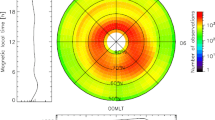Abstract
We present a comparison of the observed behavior of the F-region ionosphere over Millstone Hill during the geomagnetically quiet and storm periods of 6–12 April 1990 with numerical model calculations from the IZMIRAN time-dependent mathematical model of the Earth’s ionosphere and plasmasphere. The major enhancement to the IZMIRAN model developed in this study is the use of a new loss rate of O+(4S) ions as a result of new high-temperature flowing afterglow measurements of the rate coefficients K1 and K2 for the reactions of O+(4S) with N2 and O2. The deviations from the Boltzmann distribution for the first five vibrational levels of O2(v) were calculated, and the present study suggests that these deviations are not significant. It was found that the difference between the non-Boltzmann and Boltzmann distribution assumptions of O2(v) and the difference between ion and neutral temperature can lead to an increase of up to about 3% or a decrease of up to about 4% of the calculated NmF2 as a result of a respective increase or a decrease in K2. The IZMIRAN model reproduces major features of the data. We found that the inclusion of vibrationally excited N2(v > 0) and O2(v > 0) in the calculations improves the agreement between the calculated NmF2 and the data on 6, 9, and 10 April. However, both the daytime and nighttime densities are reproduced by the IZMIRAN model without the vibrationally excited nitrogen and oxygen on 8 and 11 April better than the IZMIRAN model with N2(v > 0) and O2(v > 0). This could be due to possible uncertainties in model neutral temperature and densities, EUV fluxes, rate coefficients, and the flow of ionization between the ionosphere and plasmasphere, and possible horizontal divergence of the flux of ionization above the station. Our calculations show that the increase in the O+ + N2 rate factor due to N2(v > 0) produces a 5–36% decrease in the calculated daytime peak density. The increase in the O+ + O2 loss rate due to vibrationally excited O2 produces 8–46% reductions in NmF2. The effects of vibrationally excited O2 and N2 on N e and T e are most pronounced during the daytime.
Similar content being viewed by others
Author information
Authors and Affiliations
Corresponding author
About this article
Cite this article
Pavlov, A.V. The role of vibrationally excited oxygen and nitrogen in the ionosphere during the undisturbed and geomagnetic storm period of 6–12 April 1990. Annales Geophysicae 16, 589–601 (1998). https://doi.org/10.1007/s00585-998-0589-5
Received:
Revised:
Accepted:
Issue Date:
DOI: https://doi.org/10.1007/s00585-998-0589-5




